In order to see the common characteristics of the most successful explainer videos, we decided to analyze a sample set of 100 explainer video examples from a variety of companies and industries.
We wanted to ensure we only looked at videos that had been widely viewed. For this analysis, we only included videos that had been viewed 100,000 times or more on either YouTube or Vimeo.
Since dialogue is an important part of an explainer video, we used transcription software on the videos to record the dialogue and number of speakers. These transcriptions were a key part of our analysis.
Here are some highlights of what we found:
- The explainer video examples in our sample were mostly shorter than two minutes and had less than 300 words.
- Dialogue happened at a moderate pace, usually less than three words a second.
- The dialogue in the explainer video examples was usually written at a seventh to ninth grade reading level.
In the big picture, our strongest recommendation is to work with an experienced explainer video company—one that can help you find the right combination of script, style, and content for your specific marketing goals. Every company is different, and what is effective for one company might not be the best approach for you.
With that said, there are some general trends that apply to the majority of the explainer video examples, and we saw a lot of what we see in our client projects reflected in the research.
Here are the detailed findings from our analysis…
Most Common Length: 1 to 2 minutes
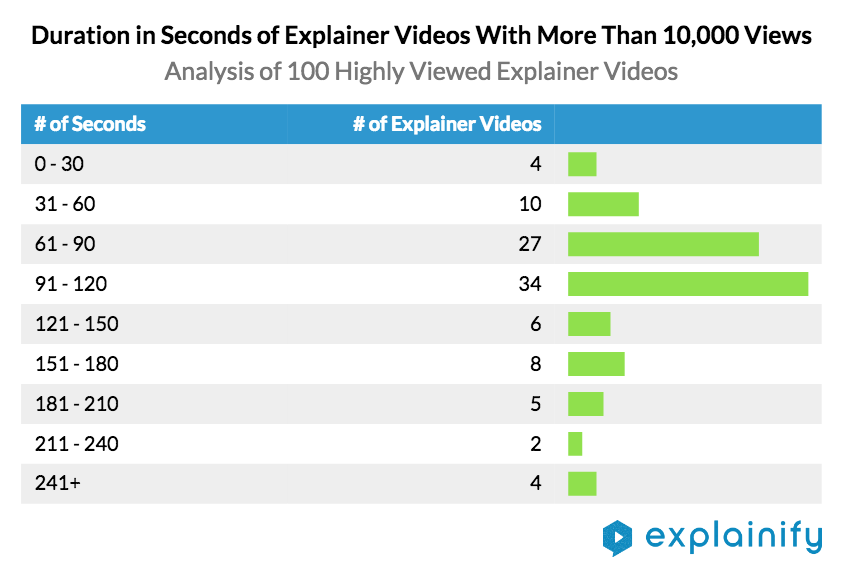
As you might expect, explainer videos tend to be short. They’re meant to tell the audience a message as quickly as possible. As research from Wistia shows, the longer a video is, the less likely viewers are to finish it:
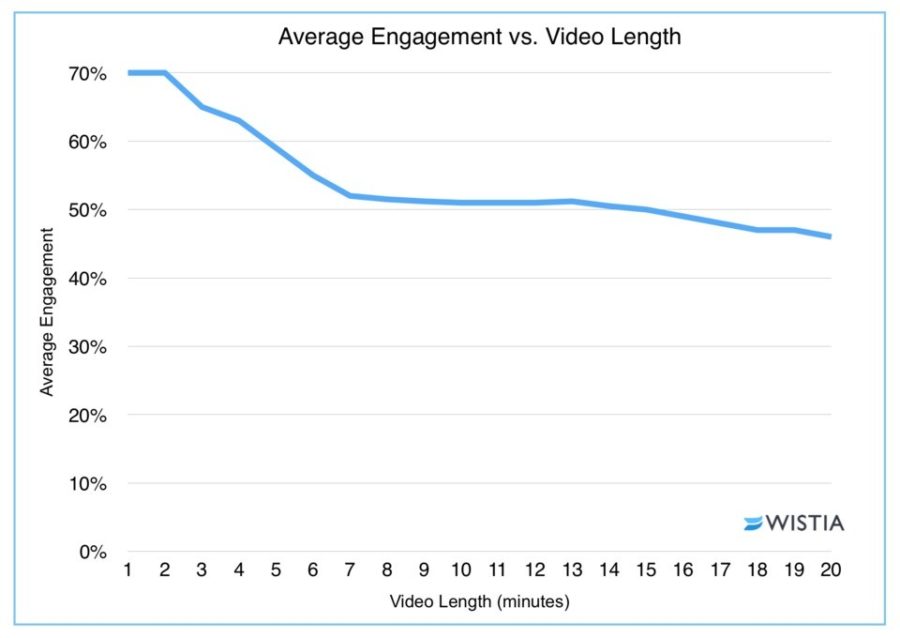
Our research of most common explainer video length matches perfectly with the research from Wistia: One to two minutes is the sweet spot of maximizing viewer engagement.
There were some notable exceptions. One of the shortest explainer videos we saw was this one about PrescribeWellness:
Since PrescribeWellness deals with consumers picking up prescriptions, they don’t have to spend as much time explaining what they do. Consumers already know a lot about the process of picking up prescriptions.
On the other hand, this ad from Capital Media is about four minutes long:
While the topic of social media ads isn’t that complicated, this particular explainer video seems to be geared towards less tech-savvy clients.
For the target audience, there’s a lot of information that needs to be conveyed before they’re willing to pull the trigger on social advertising. That could explain why it’s slightly longer than the average explainer video.
Most Common Script Length: 100 to 300 Words
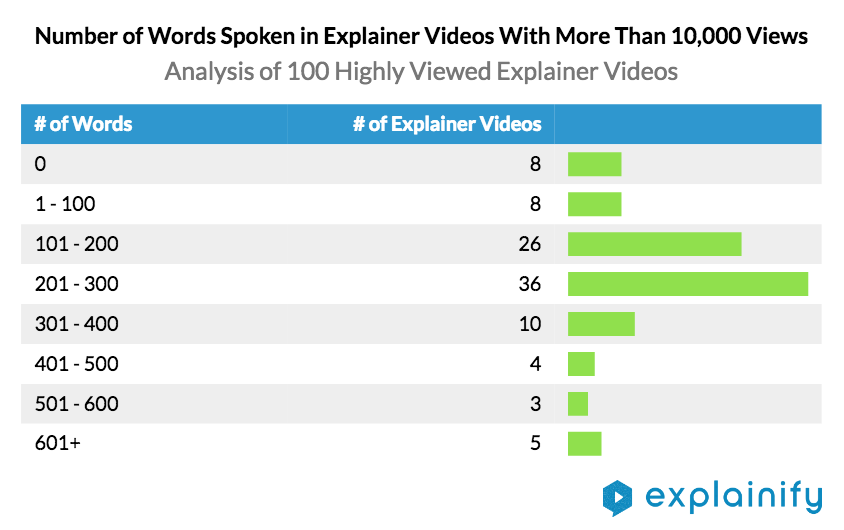
Not only do you not have much time to explain yourself in an explainer video, but you also need to try to keep your dialogue under 300 words.
Just for reference, research from Newswhip shows that a viral New York Times article typically is over 1,000 words long. We didn’t see a single explainer video with 1,000 words.
One of the longer explainer videos we saw was this one from Mulesoft explaining what an API is:
An API is an interface for allowing software from different entities to communicate. Entire books have been written on the importance of an API, so it makes sense that Mulesoft had to use more words to fully explain themselves.
Keep in mind that it’s possible to create a successful explainer video without any words at all. This explainer video about Spotify contains no dialogue at all:
The whole point of the video is to convey that Spotify allows you to listen to any music you want on any device. When you have an extremely simple message, just having a few animations and words can be more than enough.
Common Dialogue Speed: 1 to 3 Words of Dialogue a Second

Estimates vary, but it’s accepted that most speakers speak at around 150 words per minute or 2.5 words per second. That’s the speed of dialogue in most of the explainer videos we analyzed.
This shows how there tends not to be too much time where no one is talking in an explainer video. It’s mostly a person talking at a normal, relatable speed from the moment the video starts to the moment the video ends.
Speed of speech is one way to change the emotional feel of a video. Consider this explainer video about Foursquare:
The dialogue happens at an average speed of 3.3 words per second. As a result, the video has a more upbeat and lighthearted feel.
Common Number of Speakers: 1 to 2
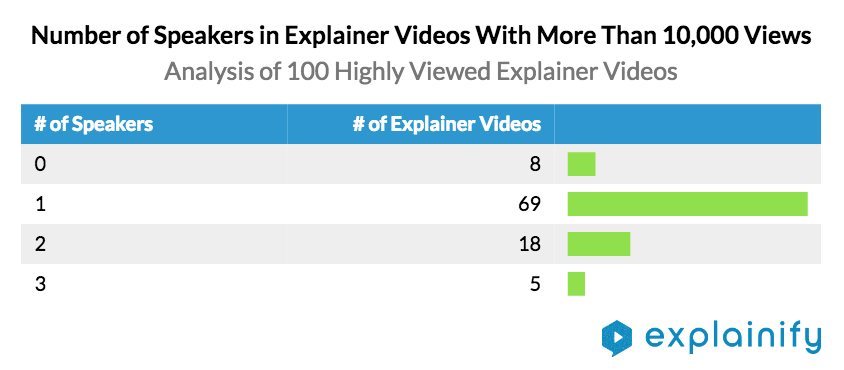
The vast majority of explainer videos have only one speaker. It’s one voice trying to convey a particular message.
When you do see explainer videos with multiple speakers, a lot of the time it’s to showcase people from the company. This explainer video from Last Bottle shows multiple people involved in the company:
On the other hand, this explainer video about the Luna mattress cover has a generic voiceover and the founder:
Common Grade Levels of Dialogue: Grade 7 to Grade 10
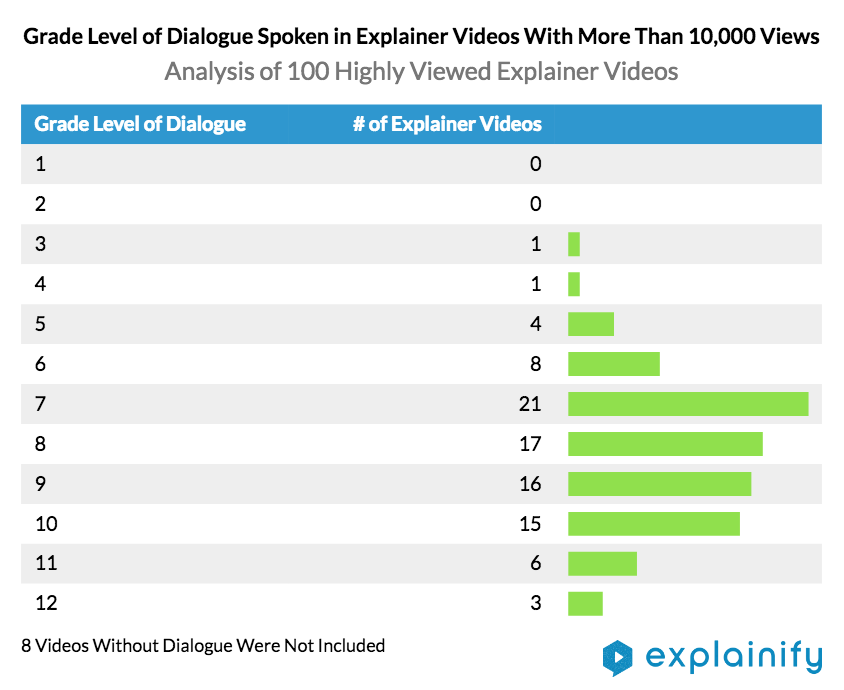
We analyzed how advanced the dialogue of the explainer videos is by calculating its SMOG grade, a widely used metric for determining readability. The SMOG grade calculates what grade level someone must be at to understand a piece of text.
While we’ve all heard the saying “keep it simple stupid”, that doesn’t always apply to explainer videos. It’s not that you want to make your videos more complicated than they need to be. You just have to be careful to make sure your script will resonate with your audience.
Keep in mind that the average American reads at a 7th or 8th-grade level. This means that 40 of the 92 explainer videos with dialogue were too advanced for the average American.
We suspect that this is because the creators of these advanced videos made these videos for a specific audience, not the population as a whole.
If you have a mass-market product that doesn’t require much explanation, then you can use simpler language.
DataFi created an explainer video to explain their VeriFi product. VeriFi is used to manage construction loans. Since this is a more niche product with advanced concepts, the SMOG grade of the script is a 12.
Another variable which could affect the readability of the script is the fact that explainer videos are so short. You need to make every word count. This may result in the script having more compact words.
Takeaways
Here are our biggest takeaways:
- Work with an explainer video company that can help you find the right balance of length, script, style, and message for your needs.
- Most videos are between one and two minutes long.
- Most videos tell their story in 300 words or less.
- The most common pace of speech is 2.5 words per second. Varying the speed of speech can impact the feel of an explainer video. Faster brings a more energetic feel but risks feeling rushed. Slower speech rates can create a more somber effect.
- Explainer videos usually only have one speaker. On occasion, it’s effective to have zero speakers. And sometimes it makes sense to have two or more.
The “common” traits of the explainer video examples in our analysis are not a guarantee of success. Instead, you should think of them as guidelines to keep in mind when making an explainer video. Plenty of successful explainer videos do not have the characteristics analyzed here.
When making your explainer video, it’s up to you to make the correct tradeoffs in your explainer video to solve your business goals.
Should you use simple or more advanced language? How many speakers should you use? Should you have them speak slower or faster?
Because of how important these decisions are, we recommend you work with an experienced and knowledgeable partner.



